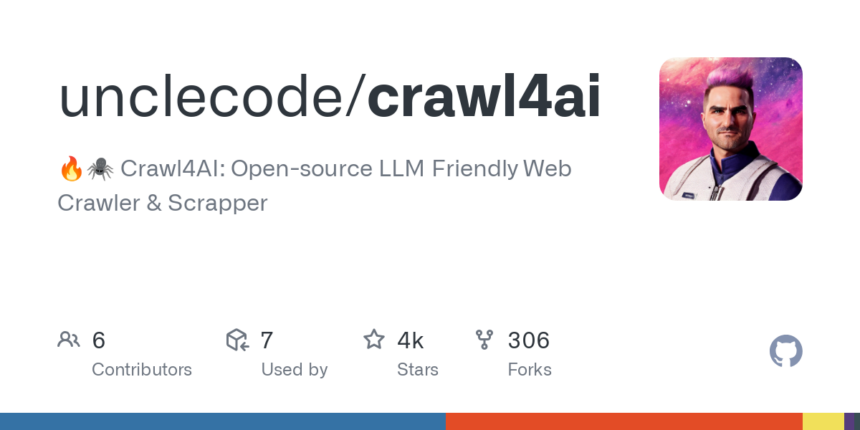In the rapidly evolving landscape of artificial intelligence, the need for efficient, scalable web scraping tools has become more critical than ever. Crawl4AI, an open-source web crawler and scraper, is a revolutionary tool designed specifically to meet the demands of large language models (LLMs) and AI-driven applications. This blog post will take a deep dive into what makes Crawl4AI a game-changer, its features, and how developers can leverage it for smarter data extraction.
Why Crawl4AI is a Game-Changer
The rise of LLMs has created a growing need for clean, structured data. Traditional web scraping tools often deliver data in formats that require additional cleaning and processing before they can be used for training or analysis. Crawl4AI tackles this challenge by offering LLM-friendly formats such as JSON, cleaned HTML, and Markdown, ensuring that the data is ready to use straight out of the box.
Moreover, its ability to crawl multiple URLs simultaneously boosts efficiency, while advanced extraction features allow for the collection of media tags, metadata, and links with ease. For developers working on AI applications, Crawl4AI simplifies the entire process of gathering the relevant information needed for tasks like natural language processing (NLP), machine learning (ML), and even AI content generation.
Key Features of Crawl4AI
1. LLM-Friendly Output Formats
- JSON: Great for structured data extraction, making it easy to parse and use for machine learning applications.
- Cleaned HTML: Removes unnecessary clutter, leaving only essential content.
- Markdown: Ideal for creating human-readable output, especially when summarizing articles or web content for reports.
2. Efficient Crawling with Multi-URL Support
One of the standout features is its ability to crawl multiple URLs simultaneously, making it highly efficient when dealing with large datasets or conducting broad searches across different web domains. Whether you’re extracting data for training a model or conducting competitor analysis, this feature significantly speeds up the process.
3. Media and Link Extraction
Crawl4AI also shines in extracting media elements like images, audio, and video, as well as internal and external links. This is particularly useful for building AI applications that require rich media content or for SEO purposes where link analysis plays a crucial role.
4. Metadata Extraction
Another powerful feature is the ability to extract metadata from web pages. This includes information such as page titles, descriptions, and keywords, which can be crucial for content analysis, SEO research, or machine learning tasks that rely on contextual data.
5. Custom Hooks for Personalization
Customization is key when scraping dynamic or secured websites, and Crawl4AI delivers through its custom hooks. Developers can inject hooks for tasks like authentication, modifying headers, or even executing JavaScript before a page is crawled. This flexibility makes it suitable for scraping complex or restricted websites.
Step-by-Step Tutorial: Getting Started with Crawl4AI
Step 1: Installation
You can install Crawl4AI through pip or Docker, depending on your preference:
Using pip:
pip install "crawl4ai @ git+https://github.com/unclecode/crawl4ai.git"Using Docker:
docker pull unclecode/crawl4ai:latest
docker run -d -p 8000:80 unclecode/crawl4ai:latestStep 2: Basic Web Scraping
Once installed, you can start scraping with just a few lines of code:
from crawl4ai import WebCrawler
# Create an instance of WebCrawler
crawler = WebCrawler()
crawler.warmup()
# Run the crawler on a URL
result = crawler.run(url="https://example.com")
# Print the extracted content in markdown format
print(result.markdown)This simple script will crawl a web page and return the content in Markdown format. You can easily switch between JSON and HTML formats depending on your needs.
Step 3: Extracting Media and Links
Crawl4AI allows you to extract media and links in addition to the text. Here’s how:
# Run the crawler and extract media and links
result = crawler.run(url="https://example.com")
# Access media and links from the result object
print("Extracted media:", result.media)
print("Extracted links:", result.links)Step 4: Using Custom Hooks for Authentication
For websites that require login credentials, you can use custom hooks to automate authentication:
def on_driver_created(driver):
driver.get("https://example.com/login")
driver.find_element(By.NAME, "username").send_keys("myusername")
driver.find_element(By.NAME, "password").send_keys("mypassword")
driver.find_element(By.NAME, "login").click()
return driver
crawler.set_hook('on_driver_created', on_driver_created)This hook logs into a website before proceeding with the crawl, making it easy to scrape protected content.
Step 5: Advanced Chunking and Extraction
Crawl4AI also offers chunking strategies like topic-based, regex, and sentence-based chunking. This is particularly useful for summarizing or analyzing large blocks of text:
result = crawler.run(url="https://example.com", chunk_strategy="sentence")With this, the tool breaks down content into manageable sections, perfect for applications like summarization or data extraction for machine learning models.
Real-World Use Cases
1. Training LLMs
Developers can use Crawl4AI to gather high-quality data for training large language models. By leveraging the LLM-friendly formats, the extracted content can be directly fed into machine learning pipelines, saving time and ensuring consistency in data preparation.
2. SEO and Content Analysis
With the ability to extract metadata and internal/external links, Crawl4AI becomes an indispensable tool for SEO specialists. The crawler helps in identifying critical SEO factors like keyword usage, link structure, and metadata quality, providing valuable insights for optimizing website performance.
3. AI Research and Data Collection
Crawl4AI is also ideal for researchers looking to collect and organize data for network analysis, machine learning projects, or AI-driven chatbots. The tool’s flexibility and powerful customization features make it a versatile choice for handling diverse data extraction tasks.
Conclusion: Crawl4AI’s Impact on Web Scraping for AI
Crawl4AI is a groundbreaking tool that simplifies the complex task of web scraping, especially for AI applications that rely on large datasets. Its LLM-friendly output formats, multi-URL crawling, and advanced extraction capabilities make it a must-have for developers and researchers alike. Whether you’re training an AI model, conducting SEO audits, or gathering data for research, Crawl4AI is the efficient, open-source solution you’ve been looking for.
Have you tried Crawl4AI yet? Let us know in the comments how you’re using this powerful tool in your projects, and share any tips or tricks you’ve discovered!
